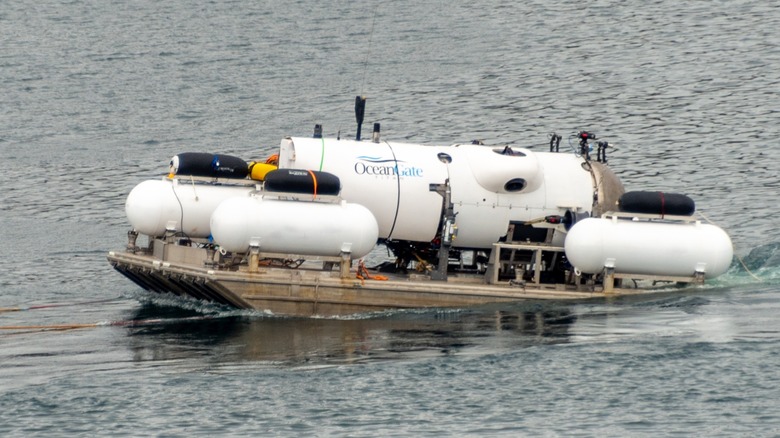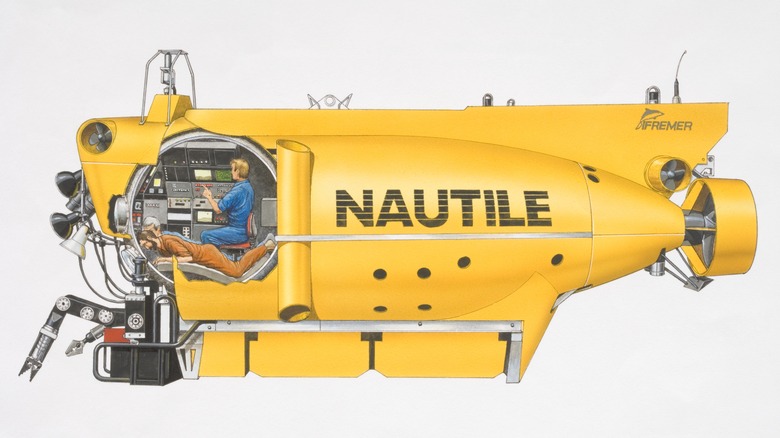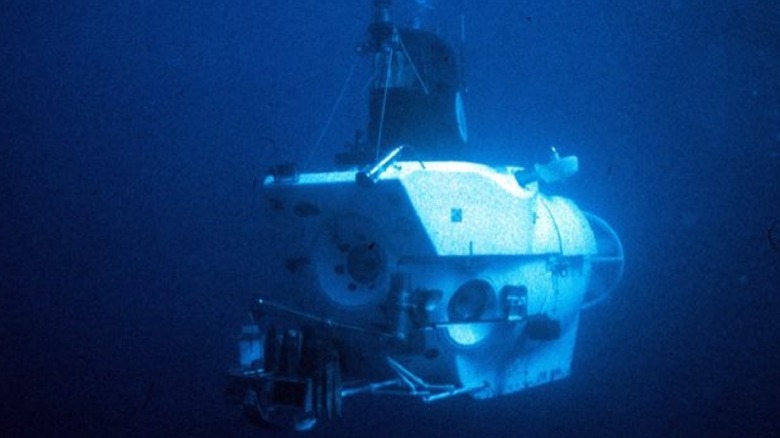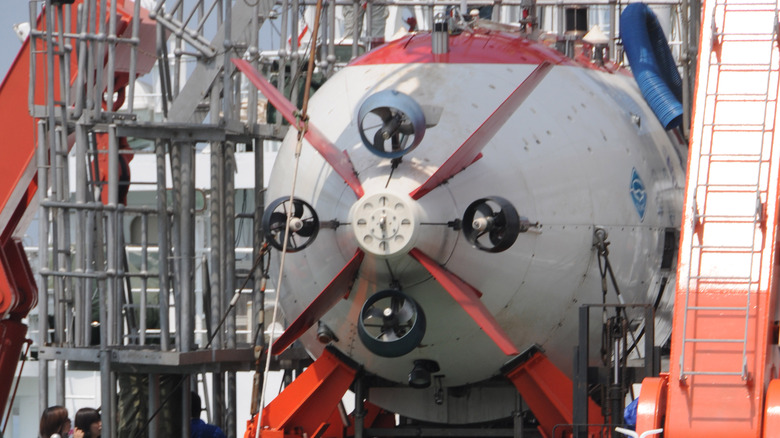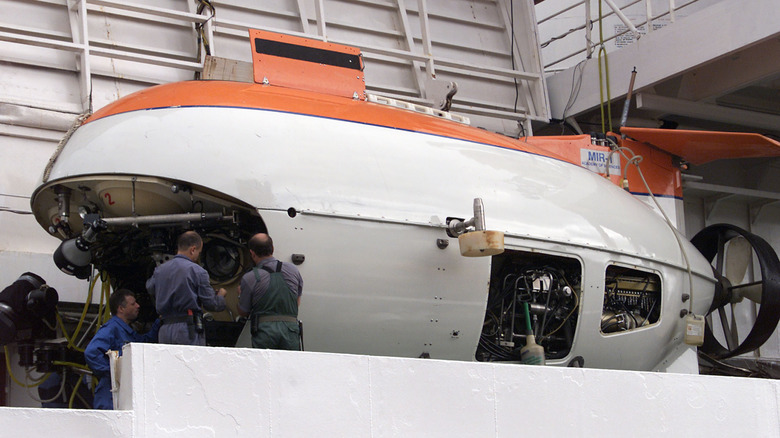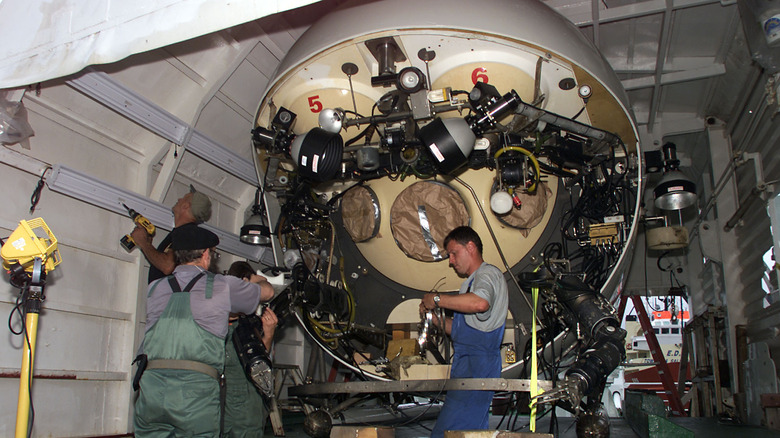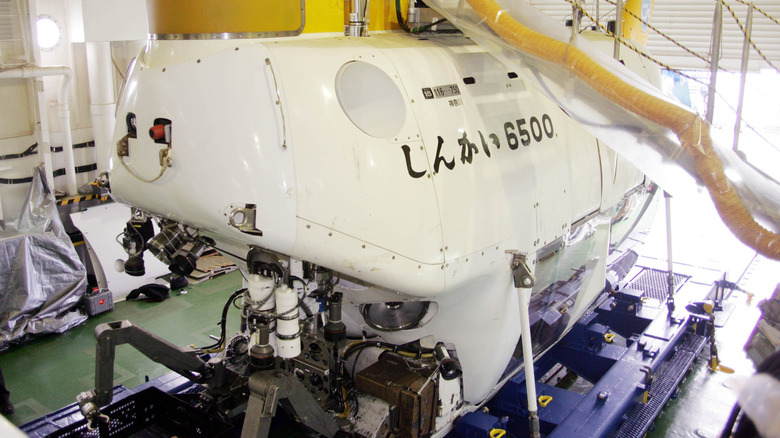There Are Only 10 Subs That Are Certified To Go To The Titanic
Following its implosion, the construction of the Titan submersible and its owner's disregard for certification and safety standards have come under increased scrutiny. As of this year, the Titan was only one of only 10 active submarines designed to dive to the depth of the storied Titanic shipwreck. However, unlike Ocean Gate's submersible, other subs are meticulously designed, rigorously tested, certified, and built using well-established methods.
Surprisingly, the list doesn't include the Deepsea Challenger, which James Cameron famously piloted to the bottom of the Challenger Deep. Like several other famous subs, it was certified as capable of diving to a greater depth than the Titanic wreck, but has subsequently been mothballed. That Deepsea Challenger was most recently on display in a California museum, and had to be restored following a fire that broke out while it was being transported the other year.
The lack of submersibles capable of surviving a 4,000-meter plunge is one of the things that hindered search and rescue efforts when it was believed there was a chance of saving those on board Titan. Not only are they rare, but they're also spaced out geographically. Only five nations have active deep-sea capable subs. France, the United States, China, Russia, and Japan. Some nations have more than others, and one of the subs on this list is actually owned by a legendary figure in the video game industry. Here is what we know about the nine other subs capable of safely reaching a depth of 4,000 or more meters.
Nautile
Nautile is a French submersible that is capable of safely hitting depths of 6,000 meters — around 50% more than you need if you want to visit the wreck of the Titanic. There's only about three percent of the ocean floor it can't reach, and its three wide-angled viewports pair with a set of LED searchlights to give the three-person crew a good view of the ocean floor. It also has a set of robotic arms that allow it to interact with, and gather things from, the sea bed. Nautile can dive for up to eight hours, and six of those can be spent on the sea bed. Other tools on board include panoramic sonar.
According to the French Oceanographic Fleet website, Nautile's current uses include: "Surveying specific areas; collecting samples and using special tools; and researching, locating, investigating and assisting in the recovery of wrecks." One of the wrecks Nautile has investigated is that of the Titanic. The sub, which was built in 1984, has visited the famous wreck several times over the years, including trips in 1987, 1993, 1994, 1996, and 1998. It has also helped recover debris from a number of air crashes.
DSV Limiting Factor
DSV Limiting Factor is a deep-water submersible owned by Gabe Newell. Yes, the Gabe Newell who also owns Valve. It is a two-man vessel and, according to the Five Deeps Expedition website, is "the world's first and only manned-submersible that will be certified for dives to 11,000 m / 36,000 ft." It can spend up to 16 hours in the water, and has a 96-hour emergency life support system if something goes wrong. Though, as we have all recently seen, 96 hours may not be enough if you end up stranded on the ocean floor.
The sub itself is primarily designed for ascent and descent. Its titanium hull is 90mm (over 3.54 inches) thick, and its controls have been designed to minimize complexity and make things simple for the pilot. The DSV Limiting Factor visited the Titanic wreck back in 2019, and was actually the first manned submersible to make the journey in close to 15 years when it went. During the trip, the Limiting Factor's crew noticed the wreck was crumbling, and famous parts like the Captain's Bathtub had disappeared between trips in 2005 and 2019.
DSV Alvin
DSV Alvin is owned by the U.S. Navy and is capable of reaching depths of around 6,500 meters. It's one of the oldest submersibles capable of reaching such levels — being commissioned way back in 1964. However, it has had numerous upgrades and refits since then, and, as a result, is still one of the most advanced submersibles in the ocean. Its seven thrusters allow it to hover in the ocean, though it is equally happy resting on the sea floor. It can make up to 10 hour dives. The Woods Hole Oceanographic Institution is currently responsible for Alvin's operation.
The submersible was used for the first manned dives to the Titanic Wreck, back in June 1986. It also suffered a near-catastrophic issue during the dive, when one of the battery chambers flooded. However, the dive was aborted and all three crew members on board surfaced safely. The battery was changed and the issue was repaired at sea, then Alvin was free to dive again. The rest of the dives went flawlessly. Robert Ballard, who had discovered the wreck the year before with an RSV called Alvin, was on board for some of the dives.
Jiaolong
Jiaolong is a Chinese vessel capable of hitting depths of a little beyond 7,000 meters — far deeper than where the Titanic's wreck sits. It hit its limits during a dive into the Mariana Trench, one of the few parts of the oceans that go that deep, back in June 2012. The submersible is 8.2 meters long, 3.4 meters high, and weighs nearly 22 tons. The Chinese-government-owned sub is one of the newer ones on this list, having entered service in 2010.
The Chinese sub's main purpose is research, and unlike several other subs on this list, it hasn't visited the Titanic wreck site. If the Chinese government wanted to view the wreck for any reason, the Jiaolong would be more than capable. Instead, it is focused on collecting samples of water, rock, and soil from the deepest parts of the ocean. The sub's robotic arms are one of the many tools that help with this task. Although China is on the short list of countries with deep-sea technology, Jiaolong isn't entirely Chinese-made. Some parts were imported, including the pressure vessel which came from Russia — another deep sea capable country.
Consul AS39
Consul AS39 is a Russian submersible capable of holding three passengers and safely diving to 6,000 meters below sea level. Although the vessel doesn't appear to be spherical from the outside, the pressure chamber itself is ball-shaped. This is generally seen as the best shape for deep-sea diving as it is strong, consistent, and lacks any notable weak points. The sub also features a set of "manipulators" or robot arms to the layman. These allow it to interact with things on the sea bed, retrieve samples, and, if you believe the rumors, engage in illicit activities that threaten global stability.
The Russian submersible and its sister Rus AS37 have been spotted with a large research ship called Yantar at a number of locations during times of political interest. It was spotted near Cuba as the island's relations with the U.S. began to improve, off the coast of Syria right before a mysterious internet outage hit the Middle Eastern nation, and it has also been sighted close to Portugal, the United States, and Canada. The Consul class submarines are the military equivalent of the Mir submarines which have completed several Titanic expeditions and taken high-profile passengers like director James Cameron to the wreck site.
Stiver
Stiver is one of several submersibles built and owned by the Chinese government — and it isn't purely made to explore or find wrecks. Like many deep-sea submersibles, it exists as a scientific research vehicle. While it is pushing the limits of what submersibles in general, can do, it primarily gathers samples from the ocean floors. As with many similar subs, those are primarily gathered with the vehicle's mechanical arms. Like many submersibles of its kind, Stiver can carry three crew members. It is also almost entirely domestically built, unlike older submersibles in the Chinese fleet, which required imported parts from other countries.
By 2021, Stiver had dived to 10,000 meters eight times, with those dives taking place in the Mariana Trench. It also holds the record of "deepest dive by a Chinese submersible" hitting 10,909 meters (35,791 feet), according to CGTN. This involved going to the bottom of the Challenger Deep, and isn't far from the all-time world record dive of 35,849 feet. All of these dives are over two and a half times the depth of Titanic , and involve pressures far greater than you would find at 4,000 meters.
Deep Sea Warrior - China
Deep Sea Warrior, which is yet another Chinese vessel, has been around since 2016. It can hit depths of 4,546 meters, has been very busy — completing over 500 dives, according to the South China Morning Post. The average dive time is 8.5 hours — though it can reportedly go for longer. Its missions have included the maintenance of an underwater lab.
While it isn't diving to the Titanic, Deep Sea Warrior isn't going to the bottom of the sea for purely scientific reasons either. It performs archeology missions too. This has included exploring wreck sites and recovering shipwrecked materials. Recently, it was part of an operation that explored two sunken Ming dynasty ships resting at a depth of over 1,500 meters. During the operation, "more than 200 cultural relics dating back about 500 years" were discovered. The recovered objects included pieces of wood, and numerous ceramic items including a blue and white porcelain dish.
RUS AS37
Rus AS37 is similar in many ways to its sibling, Consul AS37. Both have spherical hulls, both are rated to a depth of 20,000 feet, both have "hydraulic manipulators," and both have been subject of scrutiny and suspicion during times of global tension between the United States and Russia.
While they are down as "research vessels" they have been known to recover downed military hardware like Russian jets. It is also possible that they could be used to splice into, and effectively tap, undersea communications cables — and remove taps other countries have placed on Russian lines. It can venture underwater for up to 12 hours, and spend at least three hours at its depth limit without issue. It also has access to a tethered unmanned submersible, which can be used to garner a different perspective on the things it is examining in the deep ocean and can venture into places where directly using the Rus AS37 would be dangerous, or the submersible simply can't fit.
Shinkai 6500
Creative wording can make a record holder of anything. Japan's JAMSTEC Shinkai 6500 is capable of going deeper than any "manned submersible for academic research" on Earth — though that may be down to other submersibles performing tasks outside of "academic research" as there are many that can dive deeper than the 6,500 meters the Shinkai 6500 is capable of.
Still, JAMSTEC's effort has performed over 1,500 dives since it first launched in 1991. Its primary focus is to "study seafloor topography and geology and research deep-sea organisms in the Pacific Ocean, Atlantic Ocean, and Indian Ocean as well as the sea around Japan," according to the JAMSTEC website.
As with many older submersibles, it has undergone extensive upgrades and refits over the years, with its biggest overhaul ever being completed in 2012. It has an interior diameter of two meters and, although slightly cramped, can accommodate up to three people. Its manipulators can lift up to 100 kg while underwater and its seven searchlights can provide around 10 meters of visibility while deep in the ocean. A regular dive on Shinkai lasts around eight hours, though it is capable of sustaining the lives of its crew members for 129 hours should something go wrong.
